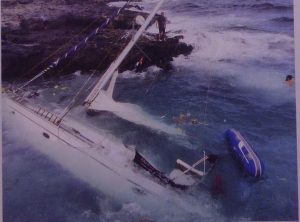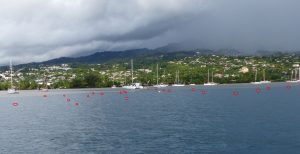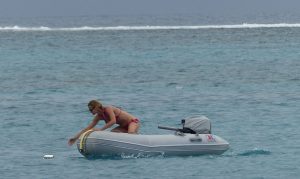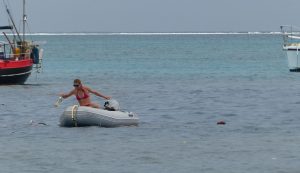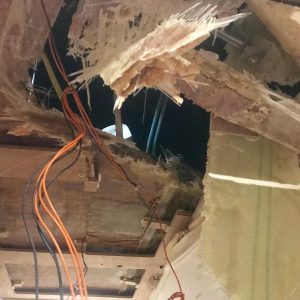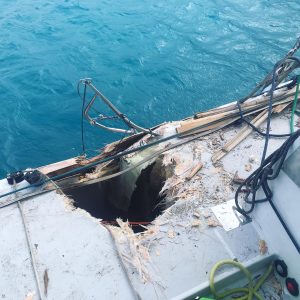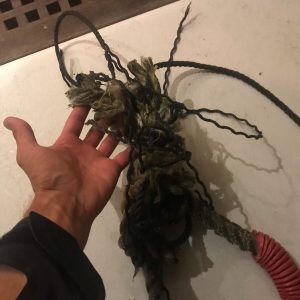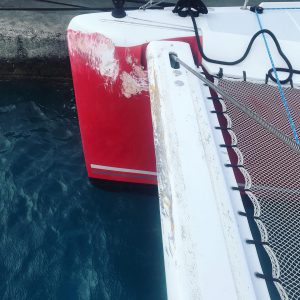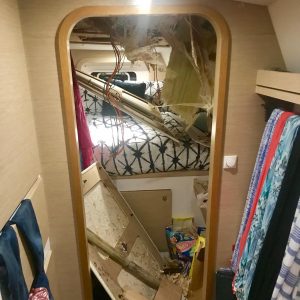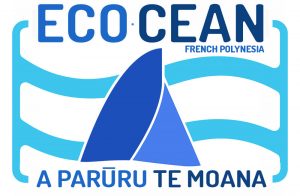Depuis la fin de l'enquête publique en mai 2019, nous avons réussi à obtenir le rapport du commissaire enquêteur que vous trouverez ci dessous en pdf à télécharger
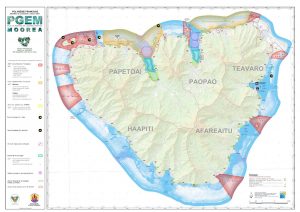
Les commentaires de l'AVP sur le rapport :
Commentaires BG sur le rapport final du commissaire-enquêteur, relatif à l'enquête publique du PGEM de Moorea
On pouvait espérer un commissaire enquêteur faisant preuve d'un minimum de « neutralité », et rendant un rapport faisant preuve d'un minimum de « sérieux » et de professionnalisme : ça n'est absolument pas le cas ;
-
-
l'absence de toutes contraintes pour les pêcheurs est entérinée sans la moindre difficulté ; l'absence de concertation avec certaines catégories d'usagers (plaisanciers, notamment) ne fait l'objet d'aucune remarque (« excellente concertation (sic) »), les conditions d'organisation de l'EP sont balayées d'un revers de main, la régularisation des situations illégales actuelles (remblais, etc) est renvoyée aux calendes grecques, etc, etc, etc.
-
Normalement, un commissaire enquêteur « pro » fournit une réponse à toutes les observations émises par écrit, même les plus « idiotes » : ici, par exemple, sur mes 36 observations, 21 n'ont aucune réponse du tout, et pour 14 autres, le CE répond sans vergogne carrément à côté...
-
Sur les 46 pages de son rapport, les 17 premières sont la recopie pure et simple du texte du PGEM lui même, et des textes légaux : du remplissage. Les pages 18 à 38 sont la recopie des observations du public, faite sous la forme de résumés déformés : là encore, quasiment du remplissage. Seules les pages 39 à 46 (avec beaucoup d'espaces blancs) sont le travail du CE : vraiment pas grand chose pour un tel dossier.
-
Enfin, son avis final s'abrite derrière le faux-nez des « recommandations », dont il sait pertinemment que le comité du PGEM peut les mettre instantanément à la poubelle sans même les lire...
Conclusion : un CE aux ordres, et un rapport où il ne prend même pas la peine de le cacher .
# Rapport rendu le 27 mai 2019, conformément à la loi (un mois après fin EP).
Pourquoi n'y a-t-il eu aucune publicité, aucune diffusion, aucune information, aucun envoi (comme promis) au rédacteur des observations, …. voire une franche hésitation lorsque nous avons commencé à demander en juillet où en était ce document ???
# pages 1 à 15 : simple recopie du contenu du PGEM.
Du remplissage ….
# page 16 : G, composition du dossier
« a été élaboré en conformité avec les dispositions du Code de l'Aménagement » : Manifestement, non, car il manque une des cartes …
# page 17 : H, organisation de la consultation
Reprise pure et simple du texte de l'arrêté ministériel.
Accès au registre uniquement en présence du CE : pour le CE, c'est le cas de toutes les EP en PF.... :
Faux (voir par exemple Arrêté n° 475 MCE/ENV du 16/01/2019 : « Pendant les heures d'ouverture de la mairie, le public peut prendre connaissance du dossier et formuler ses observations sur le registre ouvert à cet effet . »)
# 150 personnes sont venues voir le dossier, et 70 ont émis des observations.
Pas d'indication du fait que des étrangers ont participé aux observations
# pages 18 à 38 : recopie des observations faites par les 70 personnes ci-dessus
Il ne s'agit pas d'une recopie stricte, mais d'un « résumé » qui déforme notablement les questions réelles...
# Page 39 à 46: analyse synthétique des observations par le CE
La présentation n'est pas destinée à favoriser la clarté de l'exposé ; habituellement, le CE fait un tableau en 2 colonnes, à gauche les observations (regroupées si elles sont émises identiquement par plusieurs personnes), à droite ses réponses. La méthode retenue par Mr Ponia lui permet de faire disparaître allègrement de très nombreuses questions …. à problèmes (dans mon cas, 21 questions sur 36 n'obtiennent aucune réponse de la part du CE).
- contenu du PGEM :
Le CE tacle gentillement les pêcheurs : disparition complète des obligations pour les pêcheurs, mais sans oser s'y opposer frontalement
Multiplications des zonages, incompréhensibles
- Accès au dossier, déroulement de l'enquête :
Rien à dire pour le CE, conforme à la lettre de la loi et aux pratiques habituelles en Polynésie (ne répond pas à mes remarques, à savoir pourquoi on ne fait pas comme en Métropole, où la loi est pourtant la même …)
- Carte manquante
Le CE n'a pas vérifié ce point (« il s'agit vraisemblablement (sic) d'une erreur de rédaction »)
- Limite des 250 m
Le CE ne fournit pas d'explication sur ce changement (par rapport aux anciens 70m)
- Dispositions transitoires (pas de date)
Le CE laisse toute liberté pour fixer n'importe quelle date (y compris dans 150 ans …): lamentable
- Gouvernance
Nombreuses observations négatives sur le sujet
Le CE impose néanmoins de définir cette prérogative au profit de la commune, y compris le contrôle sur terrain..., malgré de nombreuses observations (y compris locales) totalement opposées du fait des conflits d'intérêts évidents
- Représentant des plaisanciers au comité permanent
Le CE dit non, avec l'argument hallucinant « les plaisanciers ne sont pas plus importants sur les visiteurs de l'île » ; heu, les visiteurs de l'île ne sont pas concernés par le PGEM (ils sont essentiellement à terre), et les plaisanciers sont aussi des … visiteurs de l'île...
- Vitesse
Le CE refuse (à juste titre) que les scientifiques puissent déroger aux limitations de vitesse
- Mouillages et quotas de voiliers
Estime que les quotas proposés sont un bon compromis (… fait sans concertation???)
Mais propose de supprimer 10 places (Tiki et Mamaa), en les reportant dans la marina prévue en fond de baie d'Oponohu
Demande la mise en place de bouées (Cook, …)
Demande gestion du mouillage (service à terre, …)
Et ne réponds pas aux propositions constructives (étaler les mouillages du nord vers les zones sud, etc …)
- Réseaux
Le CE confirme de préciser clairement les zones de protections (ça coûte rien ...)
- Autorisations d'Occupation Temporaire du domaine maritime (AOT)
Le CE demande l'interdiction des AOT à venir, même pour les hôtels....
Nota : les Zones de Mouillage Organisées (bouées payantes) sont aussi des AOT !!!
- Fouilles archéologiques
Le CE n'a rien à dire (et pour cause, y'a pas eu d'observations …!)
- Recherche scientifique
Le CE est d'accord avec les demandes des scientifiques, + bilan annuel & cartographie
- Accès à la mer
Le CE souhaite qu'on recherche d'autres accès
Limiter les crèmes solaires, monoï, etc …
- Kitesurf
Le CE ne se mouille pas, et ne répond en rien à l'observation des kitesurfers.
Demande l'interdiction de la zone de Teavaro
- Pêche au fusil
Le CE renvoie sur le (futur) comité des pêcheurs les décisions sur la réglementation des activités de pêche ….
Là, clairement, il est PRO-pêcheurs
- Nourrissage
Le CE fait une phrase alambiquée, pouvant être lue dans les deux sens : totalement interdit, ou autorisé...
- Temae (lac)
Diverses recommandations du CE ; je ne sais pas si ça va dans le bon sens ou non
- Cétacés
Le CE souhaite que l'on précise les règles dans les passes
- Petite marina fond de baie Oponohu
Le CE souhaite que l'on rende le PGEM compatible avec cette marina
- Observation raies et requins
Le CE ne souhaite pas de nouveaux sites
- Sites de plongées
Le CE ne se mouille pas : approbation du comité permanent pour les 3 nouveaux sites (c'est déjà écrit dans le PGEM)
- Hydravions
Le CE demande l'interdiction complète … : tiens, là, il prend un avis ferme … ?
- Développement touristique
Pour le CE, pas d'incompatibilité entre réduction de la plaisance et développement du tourisme (sans argumentation, évidemment …)
- Final
Rahui
Liaison PGA/PGEM (rejets terrestres, assainissements, pesticides,...)
Programmes éducatifs dans les écoles
Spots télévisés, articles presse
Ca fait bien , ça remplit la page, et ne mange pas de pain ….
# Page 46: Conclusion
« Avis favorable en recommandant de tenir compte de mes recommandations ».
Le CE ne peut émettre que 4 types d'avis final :
- Favorable
- Favorable avec réserves (à lever par le pétitionnaire)
- Favorable avec recommandations (le pétitionnaire est libre de les lire ou pas )
- Défavorable
Dans le cas présent, le comité, et le gouvernement, sont totalement libres de faire ce qu'ils veulent du texte du PGEM présenté...
Divers
-
- Le CE ne parle nulle part du problème signalé à de multiples reprises, l'absence de concertation avec les voiliers (hormis une phrase générique « excellente concertation ») : il est manifestement coincé sur ce point.
Suite chronologique
On ne saura plus rien jusqu'à la mise la publication de l'arrêté promulguant le texte (modifié ou non) du PGEM révisé.
Avant ou après les élections municipales de 2020 ?
A télécharger :
Rapport CE_Enquête publique PGEM révisé
Commentaires sur rapport CE 2019 EP PGEM Moorea







